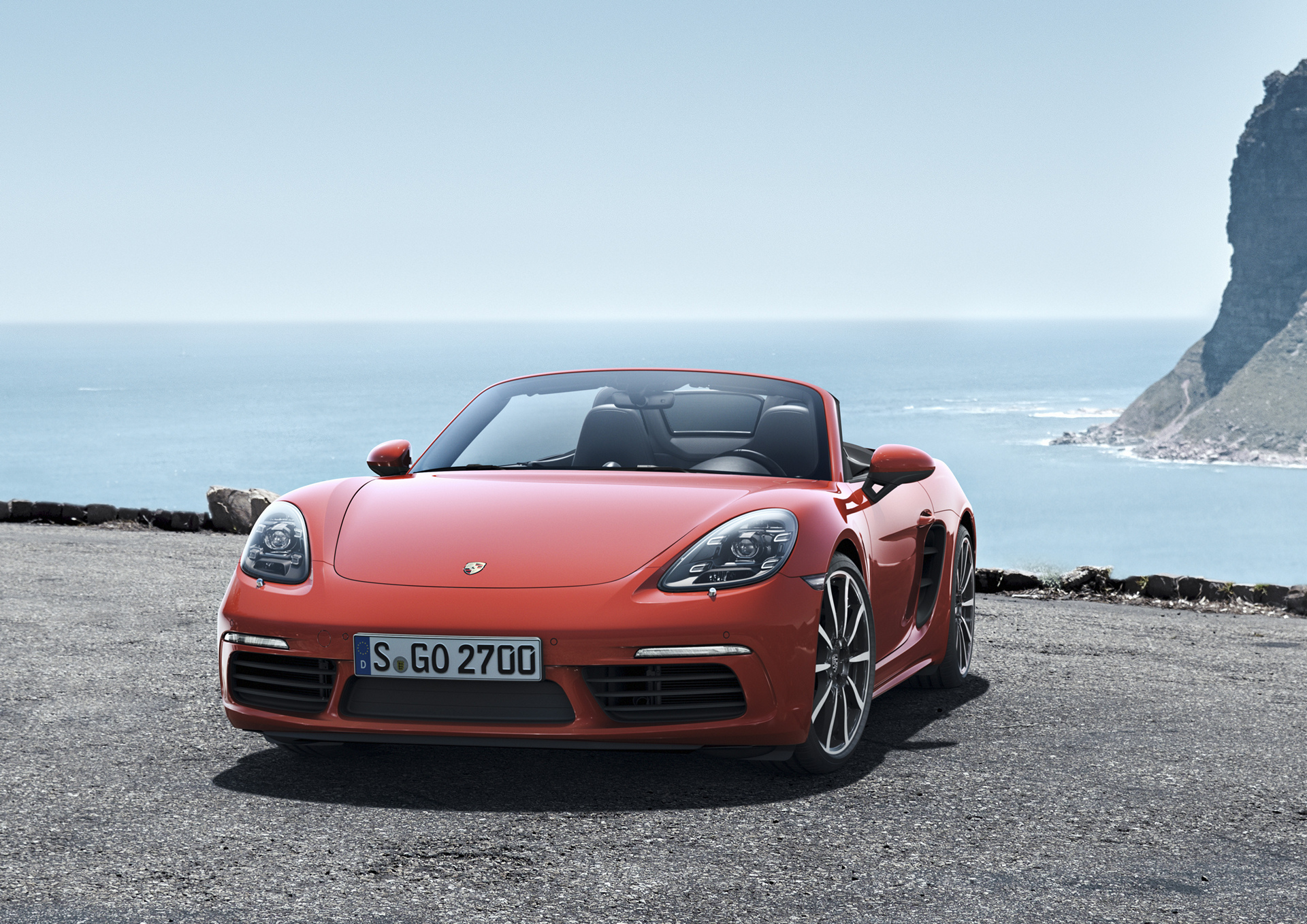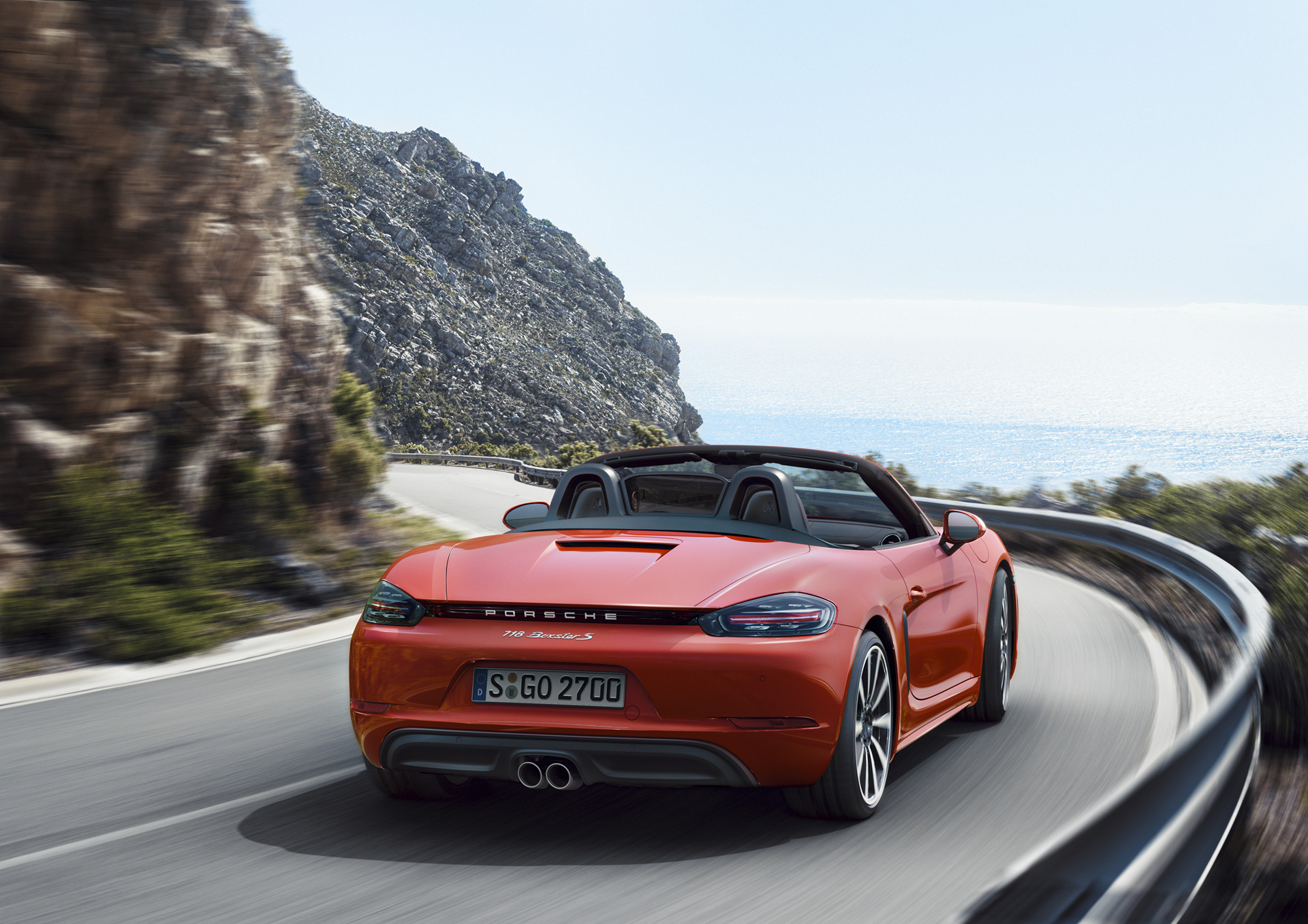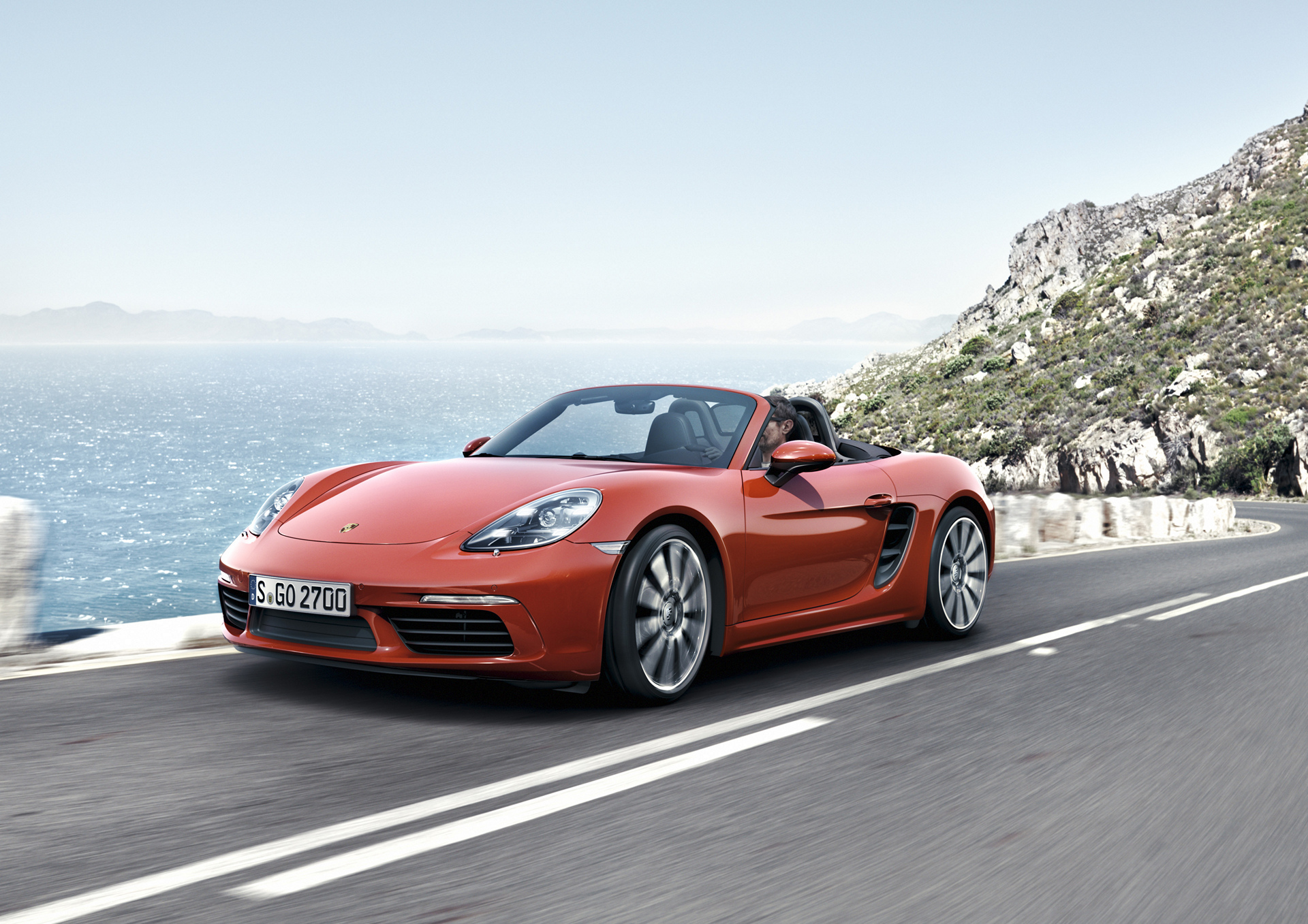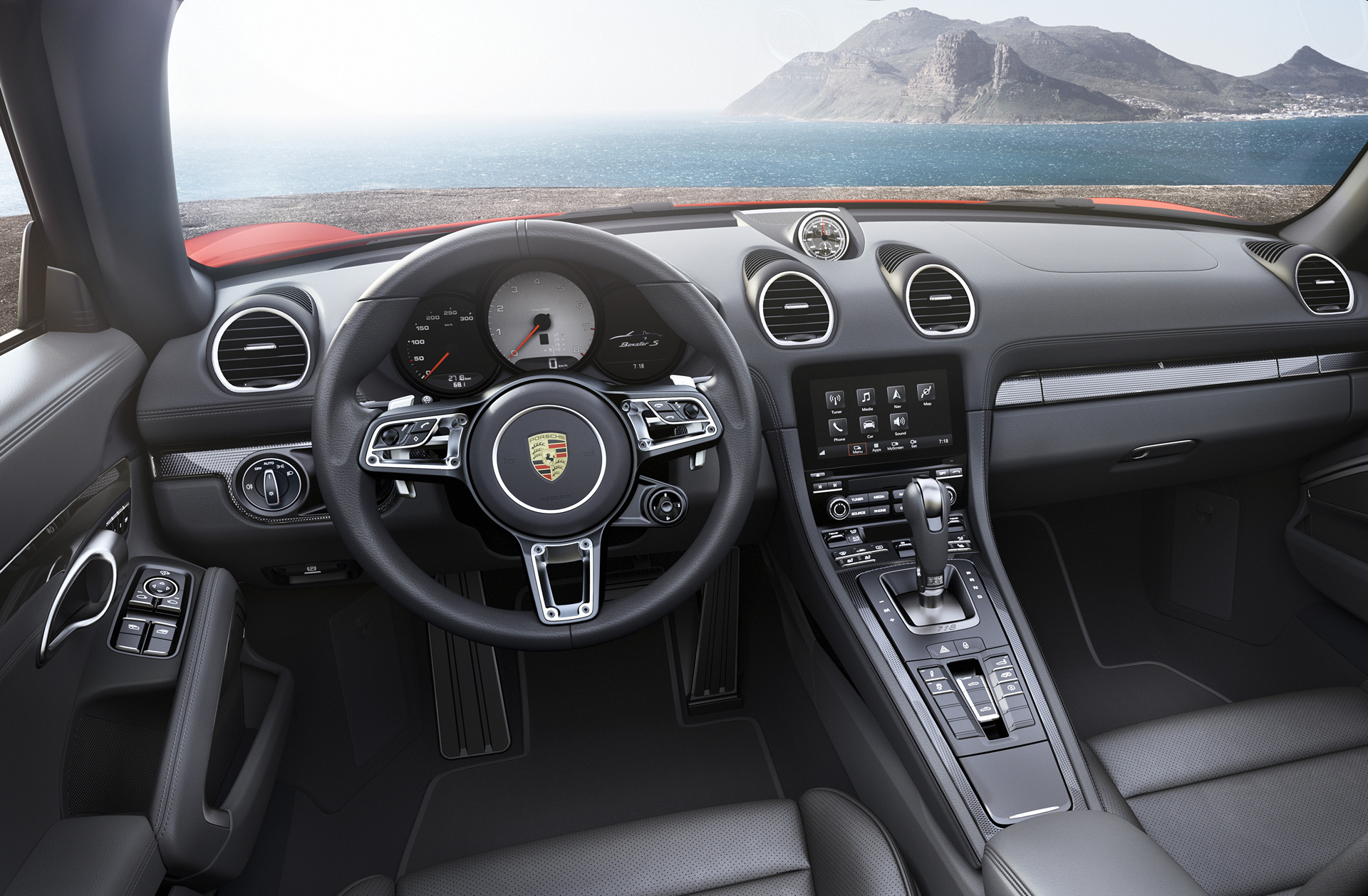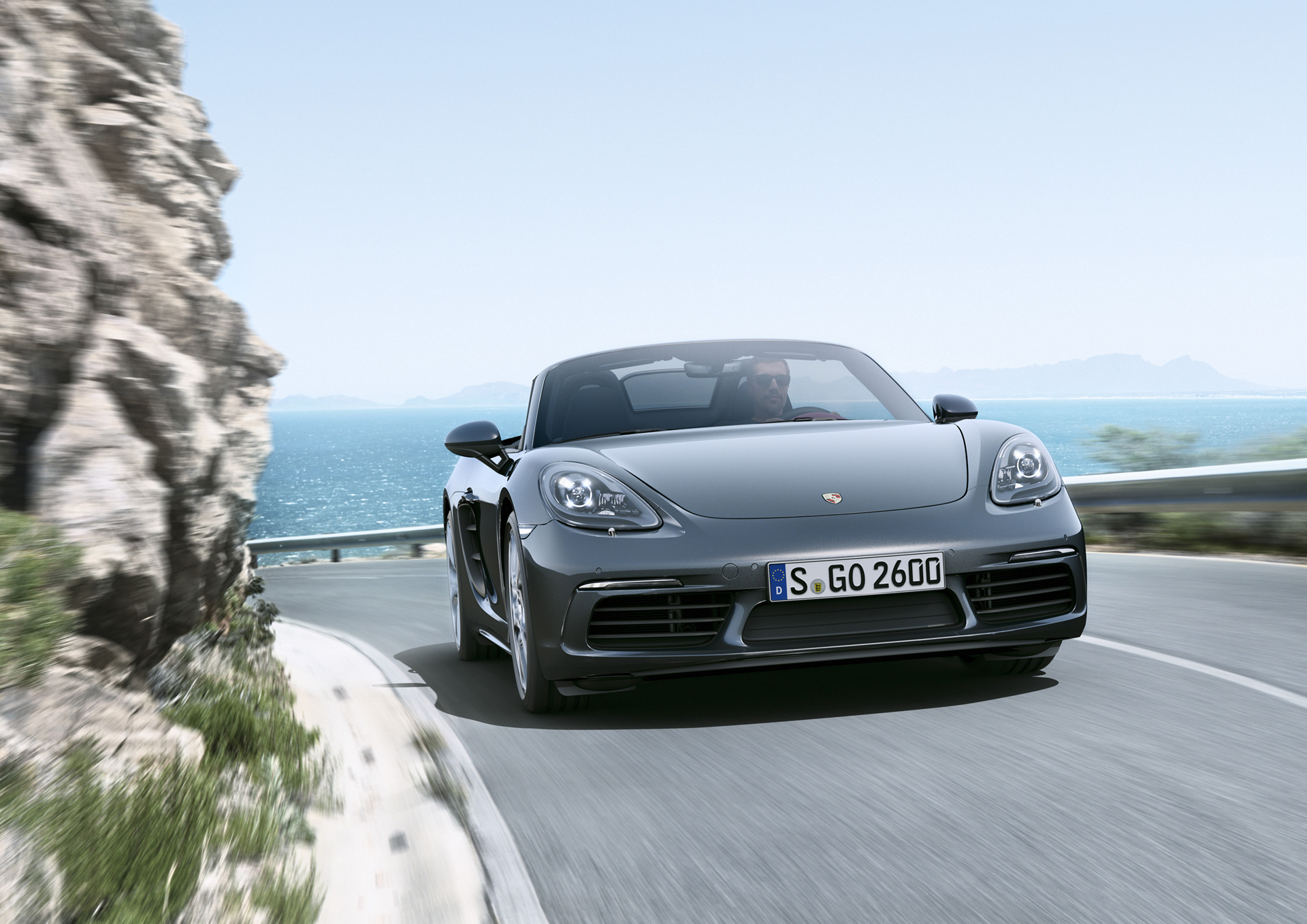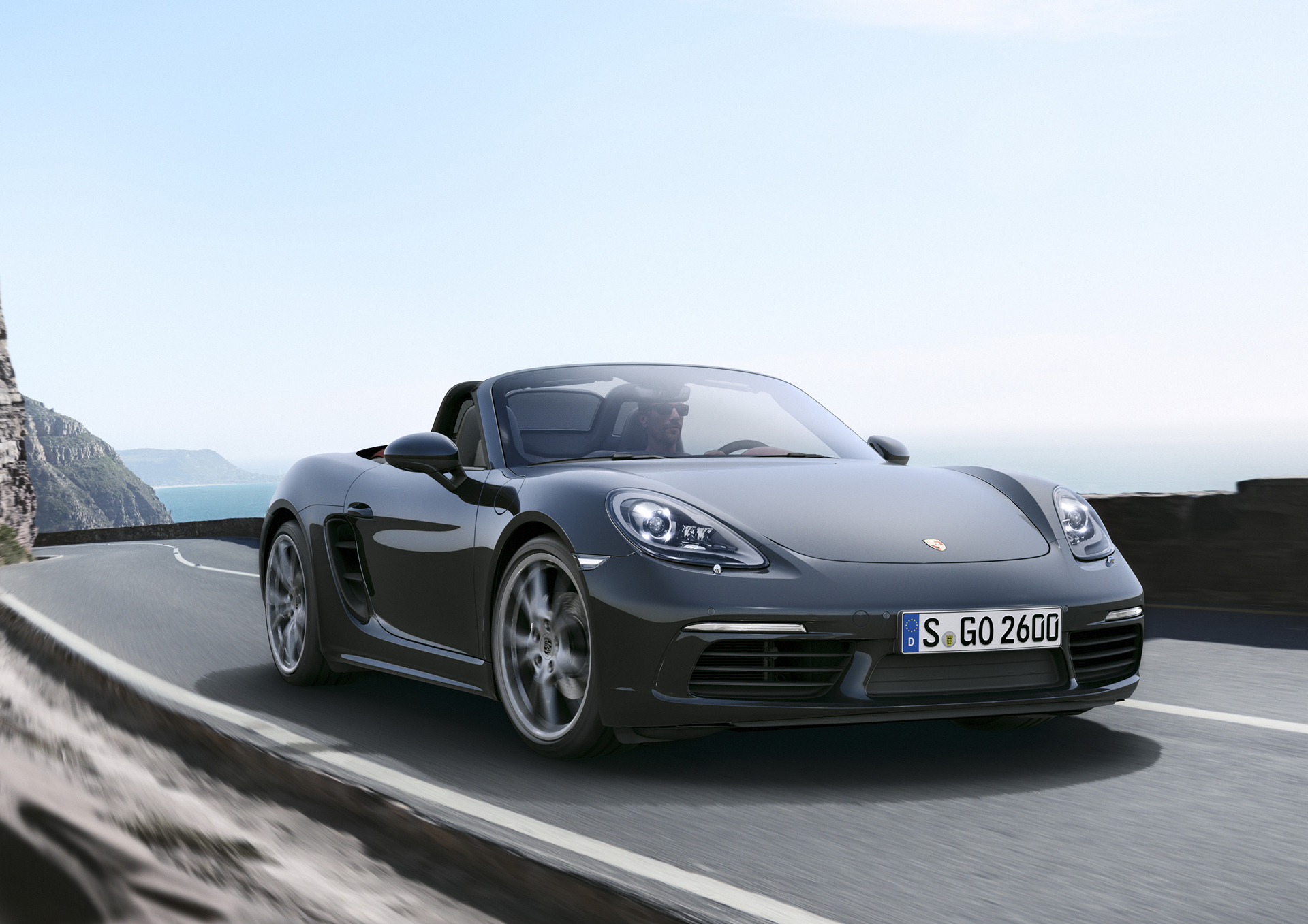The Porsche 718 Boxster offers unfiltered driving pleasure with its superior driving dynamics on any road. The authentic roadster – with its manually operated lightweight top – marks the pinnacle of the Porsche 718 Boxster line-up, featuring the most powerful engine and best driving performance of any Boxster ever built.
Performance
Test runs on the North Loop of the Nürburgring demonstrate the formidable power and wellbalanced handling of the mid-engine roadster. Its lap time of 7 minutes 47 seconds on the famed track is eight seconds faster than that of the Boxster GTS (7:55 min).
Engine / gearbox
At the heart is a 3.8-liter six-cylinder engine from the 911 Carrera S with 375 hp (276 kW) and a six-speed manual transmission. Zero to 60 mph in 4.3 seconds, top track speed of 180 mph. The highly responsive flat-six with its large power reserves guarantees driving pleasure on any road.
Design
The lightweight top lowers the car’s center of gravity and gives the roadster a characteristic design. Two striking elements, known as “streamliners”, that stretch from behind the head restraints over the long trunk lid are reminiscent of the 718 Boxster of the 1960s.
Lightweight design
At 2899 pounds, the Boxster is the lightest model in the current Boxster range. The vehicle’s power-to-weight ratio has been reduced to 7.7 pounds per hp by the use of aluminum, magnesium, lightweight polymers and reduced insulation. This makes the 718 Boxster handle quite nimbly, while offering the acceleration of a high-performance sports car.
Options
To save weight, the 718 Boxster comes without radio or air conditioning. However, consumers can opt for air conditioning as well as any of the audio systems offered for the Boxster – including the Burmester system. The basic air conditioning system and CDR audio unit are available at no charge.
Pure roadster
Porsche continues to expand the range of uncompromised sports cars in 2015. Making its debut after the Cayman GT4 and 911 GT3 RS, the 718 Boxster marks a new edition of the purist roadster. Starting at an MSRP of $82,100 plus $995 destination charge, the new top model of the Boxster range retains the unique character of the previous Boxster, which has already become an automotive icon.
Once again, the classic fabric top is operated manually, and the new car is offered exclusively with a six-speed manual transmission. In the most powerful Boxster of all time, driver and passenger alike can look forward to a genuine sports-car experience beyond compare. Test runs on the North Loop of the Nürburgring prove this convincingly. It takes just seven minutes and 47 seconds for the 718 Boxster to lap the legendary German track.
The most powerful Boxster: six-cylinder from the 911 Carrera S develops 375 hp
Powering the 718 Boxster is a mid-mounted, 3.8-liter six-cylinder direct-injection engine that was adapted from the 911 Carrera S and also drives the Cayman GT4. In the mid-engine roadster, the powerplant delivers 375 hp (276 kW) at 6,700 rpm, which is 45 hp more than the 3.4-liter engine in the Boxster GTS develops.
Producing 310 lb.-ft. of torque between 4,750 and 6,000 rpm, 30 lb.- ft. more than the Boxster GTS, the Boxster accelerates from a standstill to 60 mph in 4.3 seconds. This is 0.4 seconds quicker than a Boxster GTS with manual transmission. The 718 Boxster can reach a top track speed of 180 mph – regardless of whether the roadster top is up or down.
The distinctive design of the 718 Boxster includes stylistic elements reminiscent of legendary Porsche sports and race cars. Two prominent bubbles behind the headrests – known as streamliners – that stretch over the long trunk lid, pay tribute to the 718 Boxster of the 1960’s, while the new supplemental safety roll bar trim creates harmonious styling. The manually operated top echoes that of earlier roadsters. Fins that extend rearwards characterize the side profile.
The front and rear fascia of the 718 Boxster come from the Cayman GT4 and emphasize the vehicle’s status as a high-performance sports car. They make the new top-of-the-range Boxster ten millimeters (0.39 inches) longer and eleven millimeters (0.43 inches) lower than the Boxster GTS. Particularly striking are the three large air intakes with black screens at the front that supply cooling air to the three heat exchangers located behind them.
Unfiltered driver engagement: lightweight top and manual transmission
As a genuine roadster, the 718 Boxster offers an authentic sports-car driving experience combined with state-of-the-art performance levels. It features a finely tuned sport suspension with a 20-mm lower ride height and a six-speed manual transmission. A simple heating system and the retractable top serve as the means to maintain the desired interior temperature, while the flat-six engine is the only sound system necessary (CDR audio unit and manual air conditioning are no-cost options).
The roadster character is completed by a manually operated lightweight top, which is only latched and unlatched electrically. Putting the top up is a cinch: you simply open the rear trunk lid and fold out the roadster top. The driver inserts the fins on the trunk lid and simply pushes a button to pull the top tight to the windshield frame. To take the top down, these steps are performed in reverse order.
Systematic lightweight concept ensures outstanding driving dynamics
The purist features of the 718 Boxster are the result of a systematic lightweight concept. At 2899 pounds, the Boxster is the lightest model in the current Boxster range, weighing 66 pounds less than a Boxster GTS with manual transmission. The large trunk lid, for instance, is made of aluminum, and the lightweight top with its unheated polymer rear window weighs 24 pounds less than the conventional automatically operated top of other Boxsters. Reduced noise insulation also lowers the vehicle’s overall weight.
The results are clearly noticeable to the driver. This car’s center of gravity is lower than that of any other Boxster, and its power-to-weight ratio has been improved to 7.7 pounds per hp. This makes the 718 Boxster handle particularly nimbly, yet it accelerates as vehemently as a high-performance sports car.
Hence, the mid-engine roadster from Porsche takes full advantage of its driving dynamics concept. Wide 20-inch wheels measuring 8.5 inches at the front and 10.5 inches in the rear are reserved exclusively for the Boxster. The rear wheels are 0.5 inches wider than the widest wheels offered on other Boxsters and further enhance the lateral grip of the modified sport chassis, which is based on the optional sport suspension offered on the Boxster GTS.
Maximum cornering precision: dynamic transmission mounts, PTV differential lock
The dynamic transmission mounts of the standard Sport Chrono package prevent movements of the engine-transmission unit, especially on twisty roads, which could have a detrimental effect on handling due to load changes. Power distribution to the rear wheels comes via a classic mechanical differential lock that is part of the Porsche Torque Vectoring (PTV) system.
The locking effect is 22 percent under power and 27 percent in overrun. In conjunction with PTV, the system improves steering response and precision through targeted brake interventions at the inside rear wheel. The electromechanical power steering originates from the 911 Turbo and the setup is more direct than in the other Boxster models, while the larger brake calipers and rotors have been taken from the 911 Carrera S.
Interior designed for drivers with sporty ambitions
More so than in any other Boxster, the interior of the Boxster conveys an atmosphere of pure driving pleasure. The steering wheel, with a diameter of 360 mm (14.2 inches), is 10 mm smaller than on other Boxsters and has already proven itself in the Cayman GT4, and the shorter gear shift lever enables very rapid gear changes.
Optional Full Bucket Seats with large lateral supports let driver and passenger directly experience the outstanding lateral grip of the new Boxster.
True to the model’s purist character, a radio and the air conditioning system are omitted to save weight. A small storage compartment serves as a functional substitute for the radio. Of course, any of the Boxster audio systems – including the Burmester sound system – is available to customers as an option. An air conditioning system can also be ordered as optional equipment, as can the Porsche Communication Management (PCM) system with all of its expected features. The manual air conditioning system and CDR audio unit are no-cost options.
Exclusive optional features: Boxster Classic package in red leather
The interior ambiance is characterized by many elements in black Alcantara®. The door opener straps are reminiscent of classic race cars. Interior trim strips are painted in the exterior color – customers can select from a total of ten colors. The Boxster Classic package, which Porsche has created exclusively for this top model of the Boxster range, is particularly striking. In this package, Garnet Red leather covers the top of the instrument panel, the seats and the sides of the center console.
Porsche Spyder: pure by tradition
The basic concept for the entire Boxster family comes from the legendary 550 Spyder from 1953. It is a mid-engine roadster concept with low weight. The classic and the contemporary vehicles alike are characterized by authenticity, high agility and maximum driving pleasure. Porsche introduced the 550 Spyder at the Paris Motor Show in October 1953. The designation “Spyder” has always stood for the open-top body form – and it still does today.
The twoseater was the first sports car from Stuttgart-Zuffenhausen to be developed specifically for racing. However, a street-legal version was also produced. In subsequent years, the Spyder – weighing just 1212 pounds – achieved numerous victories on racetracks and in popular road races from the time.
The 550 was followed by other extremely successful Porsche Spyders with a racing purpose, such as the 718 RS 60 of 1960. In the mid-1960s, Porsche introduced the Bergspyder of the 904 and 906 model series. In 1967 and 1968, the 910 Bergspyder won the European Mountain Championship. In the early 1970s, Porsche developed the 908 and 909 Bergspyder race cars specifically for the Nürburgring and Targa Florio races. They were followed by the 936 Spyder for the circuit racetrack. Finally, the RS Spyder made its debut in 2005 and became the winner of the American Le Mans Series.
Among the road-going sports cars, the designation “Spyder” was revived in the Boxster S “50 Years of the 550 Spyder” edition, which made its debut at the Detroit Auto Show in early 2004. Limited to 1953 units worldwide, thus paying homage to the year the 550 Spyder was introduced, this special edition of the Boxster S was painted in GT Silver metallic and featured a 264 hp engine, sportier suspension settings, 5 mm wheels spacers, 18-inch Carrera wheels with spokes painted in Seal Grey, a manual transmission with 15 percent shorter gear shift travel, as well as a Cocao Brown top. In 2007, the Boxster RS 60 Spyder paid tribute to the 718 RS Spyder.
The power-enhanced, limited edition model was characterized by an engine producing 303 hp thanks to a modified exhaust system, a Sport Design front end, wheel spacers as well as its’ unique interior held in Carrera Red with GT Silver metallic trim. Production was limited to 1,960 units worldwide, less than 800 of which were sold in North America. The predecessor of the new 718 Boxster made its debut in 2010; it was the third and most purist variant available after the Boxster and the Boxster S. Its low slung, lightweight fabric top, which extended far towards the rear, provided only basic protection against sun and weather.
When the top was up, the lower side windows and two striking streamliners on the continuous surface of the trunk lid gave the 718 Boxster an extended silhouette similar to that of the Carrera GT. Around two months after the extraordinary Boxster made its debut, Porsche presented the concept of the 918 Spyder, a super sports car with a hybrid drive system.
Lightweight top with simplified operation
The specially developed, manually operated lightweight top of the new Porsche 718 Boxster carries the purist design of the previous model with its characteristic open fins and rear trunk lid with two distinct streamliners. Operation of the top was simplified significantly, which enhances its everyday practicality.
Lightweight design prioritized over convenience
In the previous Porsche 718 Boxster, the top was designed to be an extremely lightweight emergency weatherguard. Its everyday practicality was compromised by its manual operation requiring 15 steps, its limited suitability for automated car washes and a recommended maximum speed of 124 mph when the top was up.
As a result, a key priority for the development of the new Porsche 718 Boxster was to improve the aforementioned limitations of the previous model while maintaining its lightweight design. This meant developing a top that is car-wash-capable and can be used at any speed, like on any other Boxster or Porsche convertible.
The newly developed Boxster top frame features a lightweight design consisting of magnesium, aluminum, plastic and – where necessary – high-strength steel. By using a polymer rear windshield and omitting a power motor, insulation, roofliner and heavy acoustic top material, weight was reduced an additional 24 pounds compared to a regular Boxster top. The specified targets of automatic car wash capability and driving at top speed are fully met thanks to the use of full-fledged seals and by tying the top cover material to every cross-bow.
The optional mesh wind deflector is inserted between the two roll bars. It reduces air turbulence when the top is down and increases everyday practicality while preserving the purist concept.
Simpler and faster operation
The top of the new 718 Boxster is still operated manually, but it has been simplified significantly compared to the previous model. It is no longer necessary to disassemble the roof from the vehicle due to the full-fledged, lightweight top frame. The time needed to raise or stow the top has dropped from three minutes to under one minute, thanks to a noticeably reduced number of steps (less than half the previous amount), as well as a more intuitive operation. Moreover, the electrically activated top latch and the two pressurized gas springs of the top frame reduce the manual operating forces required to raise or stow the top.
Price
Recommended retail price (MSRP) starts from $56,000




































